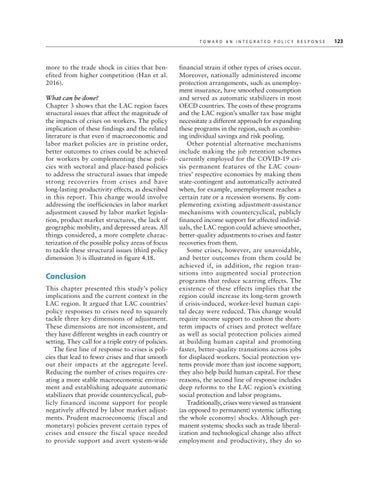T o w a r d a n I n t e g r a t e d P o l i c y R e s p o n s e
more to the trade shock in cities that benefited from higher competition (Han et al. 2016). What can be done? Chapter 3 shows that the LAC region faces structural issues that affect the magnitude of the impacts of crises on workers. The policy implication of these findings and the related literature is that even if macroeconomic and labor market policies are in pristine order, better outcomes to crises could be achieved for workers by complementing these policies with sectoral and place-based policies to address the structural issues that impede strong recoveries from crises and have long-lasting productivity effects, as described in this report. This change would involve addressing the inefficiencies in labor market adjustment caused by labor market legislation, product market structures, the lack of geographic mobility, and depressed areas. All things considered, a more complete characterization of the possible policy areas of focus to tackle these structural issues (third policy dimension 3) is illustrated in figure 4.18.
Conclusion This chapter presented this study’s policy implications and the current context in the LAC region. It argued that LAC countries’ policy responses to crises need to squarely tackle three key dimensions of adjustment. These dimensions are not inconsistent, and they have different weights in each country or setting. They call for a triple entry of policies. The first line of response to crises is policies that lead to fewer crises and that smooth out their impacts at the aggregate level. Reducing the number of crises requires creating a more stable macroeconomic environment and establishing adequate automatic stabilizers that provide countercyclical, publicly financed income support for people negatively affected by labor market adjustments. Prudent macroeconomic (fiscal and monetary) policies prevent certain types of crises and ensure the fiscal space needed to provide support and avert system-wide
financial strain if other types of crises occur. Moreover, nationally administered income protection arrangements, such as unemployment insurance, have smoothed consumption and served as automatic stabilizers in most OECD countries. The costs of these programs and the LAC region’s smaller tax base might necessitate a different approach for expanding these programs in the region, such as combining individual savings and risk pooling. Other potential alternative mechanisms include making the job retention schemes currently employed for the COVID-19 crisis permanent features of the LAC countries’ respective economies by making them state-contingent and automatically activated when, for example, unemployment reaches a certain rate or a recession worsens. By complementing existing adjustment-assistance mechanisms with countercyclical, publicly financed income support for affected individuals, the LAC region could achieve smoother, better-quality adjustments to crises and faster recoveries from them. Some crises, however, are unavoidable, and better outcomes from them could be achieved if, in addition, the region transitions into augmented social protection programs that reduce scarring effects. The existence of these effects implies that the region could increase its long-term growth if crisis-induced, worker-level human capital decay were reduced. This change would require income support to cushion the shortterm impacts of crises and protect welfare as well as social protection policies aimed at building human capital and promoting faster, better-quality transitions across jobs for displaced workers. Social protection systems provide more than just income support; they also help build human capital. For these reasons, the second line of response includes deep reforms to the LAC region’s existing social protection and labor programs. Traditionally, crises were viewed as transient (as opposed to permanent) systemic (affecting the whole economy) shocks. Although permanent systemic shocks such as trade liberalization and technological change also affect employment and productivity, they do so
123

